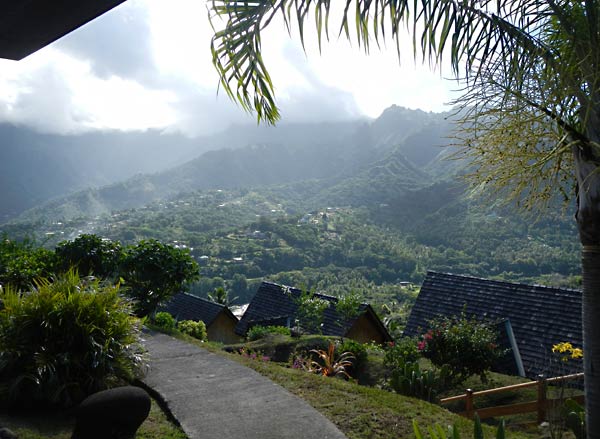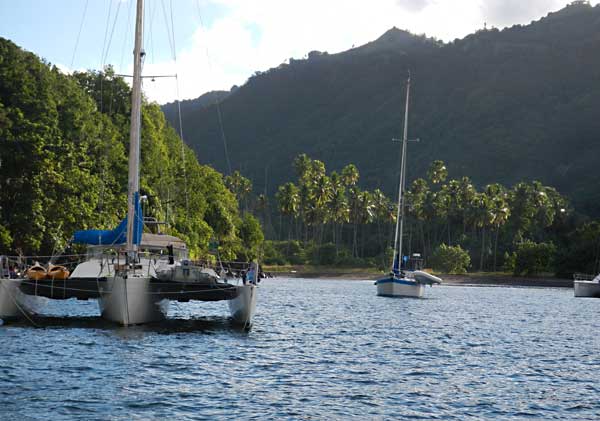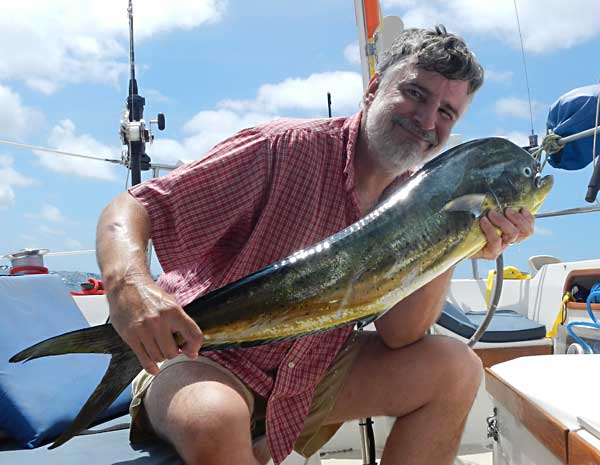
May 25 – 29, 2012
For anyone wondering what we do all day, every anchorage is different. But here, I’ll recount a typical day in Hiva Oa.
–5:30 am to 8am: Wake up to the peaceful sounds of water gently breaking on the rocks and 10 thousand screaming roosters all trying to outdo each other. Get up, put the big, comfortable West Marine chairs outside, make coffee and then go and enjoy one of best reasons for going cruising in the first place: drinking morning coffee in scenic places.
Relax, enjoy the morning air as it’s cool, watch the bay come to life and see what the other cruisers are up to. Watch the show when someone tries to sail away as invariably someone else has put an anchor chain on top theirs. In a small bay where there are a lot of boats and everyone uses a bow and stern anchor, this is the result. You just have to accept this and know that when it’s your turn to leave, you need to make sure the people in front of you and behind you are on their boats and ready to take up their anchors.
–8 to 9am: Go ashore. This is the time to see our agent, who comes down to the dock, and take care of whatever business we might have: turning over laundry or getting it back, (she runs the laundry service, too) getting paperwork she may have prepared, getting accompanied to customs and immigration, or perhaps getting some fruit not sold in the stores. We also get to mingle with other cruisers gathered there dealing with their laundry and paperwork. When she heads back to town, she’ll take as many people as can fit in her Land Rover; so everyone piles in as best they can.
–9:30 to 10:30: This is the time to shop at one of the small grocery stores or the hardware store and to go to the park to look for the trucks selling produce or fresh fish. The produce lady collects fruit and vegetables from local gardens, and there is a surprisingly good selection of freshly picked stuff: tomatoes, cucumbers, papaya, green beans, chiles, two types of lettuce, and large local grapefruit called pamplemousse. There is often someone selling large cuts of fish, tuna and “white tuna” which may be yellowtail or wahoo (whatever it is, it’s fabulous). Then we go to the market where we can buy things like cheese, eggs, apples, oranges, pears, carrots, onions and potatoes. And always, there are fresh baguettes, which people eat daily here. We get a baguette or two for the boat, and one to eat as we’re walking around, plus maybe a delicious apple tart thing our favorite store sells. (There are plenty of canned goods, but we still have plenty of canned stuff on the boat.)
What we don’t buy is chicken, beef, or milk. You would think with all the chickens running around they’d have it for sale, but it seems that those chickens are not good for eating. The only chicken parts sold (at least that I’ve seen) are drumsticks. And they have very little in the way of red meat, all frozen and expensive small steaks from New Zealand. While there is plenty of whipping cream and butter, there is no milk except for the powdered kind. They also don’t sell mangoes or bananas which are so plentiful here they don’t feel the need to sell them (we had to get them from our agent). We may also visit the ATM at the bank, which is in an air-conditioned enclosure and feels great after all the walking around.
–10:30 to 11:30: Now, it’s getting time to make the walk back to the boat, but we might go to the little lunch eatery and get an espresso while we wait for the start of lunch service at 11, when we can get a wonderful chicken curry. If not, we have something on the boat.
–12:00 to 4:00: The first thing we learned here is that the town mostly closes from 11 to 2:30, and there is a good reason for this: it gets hot. As a rule of thumb, it’s best to not exert yourself at this time of day, but instead to stay in the boat, fans on, and enjoy some reading or a nap. By the time we get back to the boat, we’re pretty hot. We open up all the hatches, turn on the fans, and I might throw on this cooling rubber towel thing I bought called a Chilly Pad. We might work on the computer, read, do small indoor boat projects, or nap. If we make lunch on the boat, it’s something cool like a sandwich.
–4:00 to 7:00: At 4, the sun is low enough to dip behind the clouds over the mountains, and then the mountains themselves. Now, the world is shaded, and it’s cool again. We put the chairs back outside and go sit in the cockpit to watch the world go by as the anchorage gets pretty active with people going to and fro. We’ll have a beer or a glass of wine or a shot of rum and enjoy watching the afternoon turn to evening. At some point, we’ll make dinner and eat that outside. Later, we might go join someone else for a drink or have them to our boat. If we’d gotten here a month or two earlier, we would be comparing passages with other cruisers from Mexico, but now most everyone here has gone through the Panama Canal and to the Galapagos before heading here. The people here are from all over the world, including a fair number of east coast Americans doing circumnavigations.
–7:00 – 9:00: We take showers and do miscellaneous computer work, then read before falling asleep early. We may have to get up during the night to close hatches if it rains, or put on the blanket as Hiva Oa can get cool overnight, sometimes approaching the low seventies!
So this is a typical day in Hiva Oa. I can see how someone could read this and think we must get terribly bored, but we don’t. When you get into the rhythm of the cruising lifestyle, the pace of life is slow, yet the days go by relatively quickly and there always seems to be plenty to do. In fact, Hiva Oa is now “big city” living for us as we live at an even slower pace at the “rural” anchorages. -Cyndi




